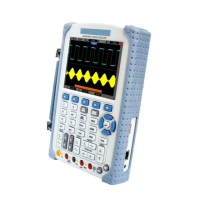Basic Operation
DSO1000B Series HandHeld Oscilloscope User Manual 24
5.4 Trigger Controls
The trigger can be defined through the Trigger Menu. There are six types of trigger: Edge, Video,
Pulse Width, Swap, Slope and Overtime. Refer to the following tables to find a different set of
options for each type of trigger.
TRIG MENU
Push this button to display trigger menus. The edge trigger is in common use. See the table below
for details.
By default the oscilloscope uses the edge trigger which
triggers the oscilloscope on the rising or falling edge of the
input signal when it crosses the trigger level (threshold).
Select the input source as the trigger signal.
CH1, CH2: No matter the waveform is displayed or not, a
certain channel will be triggered.
AC Line: Uses a signal derived from the power cord as the
By default, the oscilloscope uses the Auto mode. In this
mode, the oscilloscope is forced to trigger when it does
not detect a trigger within a certain amount of time based
on the TIME/DIV setting. The oscilloscope goes into the
scan mode at 80ms/div or slower time base settings.
In the Normal mode, the oscilloscope updates the display
only when it detects a valid trigger condition. New
waveforms are not displayed until they replace old ones.
Use this mode to just view valid triggered waveforms.
Only after the first trigger does the display appear.
Coupling
AC
DC
HF Reject
Select the components of the trigger signal applied to the
trigger circuitry.
AC: Blocks DC components and attenuates signals below
Frequency Cursors

